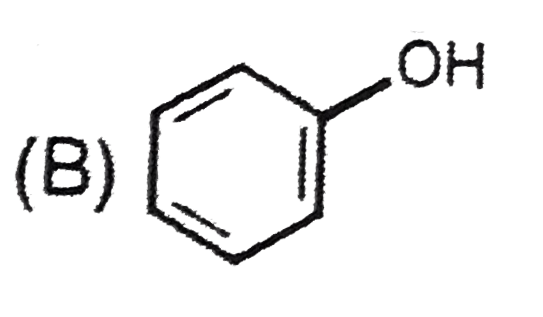The most acidic among the following is
CH3CH2OH
C6H5OH
CH3COOH
CH3CH2CH2OH
The correct Answer is:C
To determine the most acidic compound among the given options, we need to analyze the stability of the conjugate bases formed when each compound donates a proton (H+). The more stable the conjugate base, the stronger the acid.
1. Identify the Compounds:
Let's denote the four options as follows:
- Option A: CH3CH2OH (Ethanol)
- Option B: C6H5OH (Phenol)
- Option C: CH3COOH (Acetic Acid)
- Option D: CH3CH2CH2OH (Butanol)
2. Determine the Conjugate Bases:
- For Option A (Ethanol), the conjugate base is CH3CH2O-.
- For Option B (Phenol), the conjugate base is C6H5O-.
- For Option C (Acetic Acid), the conjugate base is CH3COO-.
- For Option D (Butanol), the conjugate base is CH3CH2CH2O-.
3. Analyze Stability of Conjugate Bases:
- Option A (Ethanol): The negative charge on the oxygen is not stabilized by any resonance or inductive effects.
- Option B (Phenol): The negative charge can be delocalized over the aromatic ring, providing significant resonance stabilization.
- Option C (Acetic Acid): The negative charge can be delocalized between the two oxygen atoms, providing resonance stabilization.
- Option D (Butanol): Similar to ethanol, the negative charge is not stabilized by resonance.
4. Compare Stability:
- Ethanol and Butanol have no resonance stabilization for their conjugate bases, making them weaker acids.
- Phenol has resonance stabilization due to the aromatic ring, making it more acidic than ethanol and butanol.
- Acetic Acid also has resonance stabilization, and the presence of two electronegative oxygen atoms allows for effective delocalization of the negative charge.
5. Conclusion:
- Between Phenol and Acetic Acid, both have resonance stabilization, but the conjugate base of acetic acid (CH3COO-) is more stable due to the ability to delocalize the negative charge over two electronegative atoms (the two oxygens).
- Therefore, Acetic Acid (Option C) is the most acidic among the given options.
Final Answer:
The most acidic compound among the given options is Option C: CH3COOH (Acetic Acid).
---
Let's denote the four options as follows:
- Option A: CH3CH2OH (Ethanol)
- Option B: C6H5OH (Phenol)
- Option C: CH3COOH (Acetic Acid)
- Option D: CH3CH2CH2OH (Butanol)
- For Option A (Ethanol), the conjugate base is CH3CH2O-.
- For Option B (Phenol), the conjugate base is C6H5O-.
- For Option C (Acetic Acid), the conjugate base is CH3COO-.
- For Option D (Butanol), the conjugate base is CH3CH2CH2O-.
- Option A (Ethanol): The negative charge on the oxygen is not stabilized by any resonance or inductive effects.
- Option B (Phenol): The negative charge can be delocalized over the aromatic ring, providing significant resonance stabilization.
- Option C (Acetic Acid): The negative charge can be delocalized between the two oxygen atoms, providing resonance stabilization.
- Option D (Butanol): Similar to ethanol, the negative charge is not stabilized by resonance.
- Ethanol and Butanol have no resonance stabilization for their conjugate bases, making them weaker acids.
- Phenol has resonance stabilization due to the aromatic ring, making it more acidic than ethanol and butanol.
- Acetic Acid also has resonance stabilization, and the presence of two electronegative oxygen atoms allows for effective delocalization of the negative charge.
- Between Phenol and Acetic Acid, both have resonance stabilization, but the conjugate base of acetic acid (CH3COO-) is more stable due to the ability to delocalize the negative charge over two electronegative atoms (the two oxygens).
- Therefore, Acetic Acid (Option C) is the most acidic among the given options.
The most acidic compound among the given options is Option C: CH3COOH (Acetic Acid).
Topper's Solved these Questions
- ALDEHYDES, KETONES & CARBOXYLIC ACIDSBOOK - NARAYNACHAPTER - ALDEHYDES, KETONES & CARBOXYLIC ACIDSEXERCISE - EXERCISE -II (H.W.)
25 Videos
- ALDEHYDES, KETONES & CARBOXYLIC ACIDSBOOK - NARAYNACHAPTER - ALDEHYDES, KETONES & CARBOXYLIC ACIDSEXERCISE - EXERCISE -III
50 Videos
- ALDEHYDES, KETONES & CARBOXYLIC ACIDSBOOK - NARAYNACHAPTER - ALDEHYDES, KETONES & CARBOXYLIC ACIDSEXERCISE - EXERCISE -I (H.W.)
15 Videos
- ALCOHOLS, ETHERS, PHENOLBOOK - NARAYNACHAPTER - ALCOHOLS, ETHERS, PHENOLEXERCISE - Assertion Reaosn
10 Videos
- AMINES & DIAZO COMPOUNDSBOOK - NARAYNACHAPTER - AMINES & DIAZO COMPOUNDSEXERCISE - Subjective type Q.
13 Videos
Similar Questions
Knowledge Check
The most acidic among the following compound is :
ACl−CH2−CH2−OHB C
C D
D
Weak acid among the following is
Asulphuric acidBhydrochloric acidCnitric acidDcarbonic acidThe least acidic among the following acids is-
ATrrichloroacetic acidBDichloroacetic acidCMonochloroacetic acidDAcetic acid
